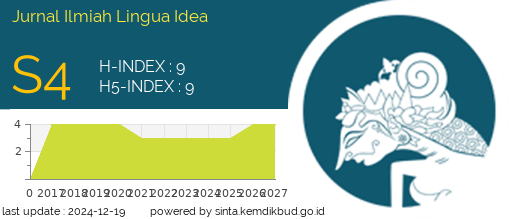The Significance of Holistic Spirituality in Sunan Kalijaga’s Kidung Rumekso Ing Wengi
Abstract
This research aims to explain the holistic spirituality of Kidung Rumekso ing Wengi by Sunan Kalijaga. In addition to being used in various situations to pray, the song needs to be studied for the sake of cultural preservation, historical understanding, literary wealth, identity, and local pride. This study is qualitative. The data used in this study consisted of documents and interviews. Data was collected through interviews and document analysis. The data validation technique uses triangulation of theory and method, while the data analysis technique uses Miles and Hubermann's interactive model and Roland Barthes' markers. Based on interviews with sources and literature studies, Kidung Rumekso ing Wengi is a counter-acceptance mantra taught by Sunan Kalijaga to his followers. Until now, there are still people who have developed hymns and the practice of hymns as a medium of prayer by paying attention to aspects of tolerance. There are various values, such as the ethics of vigilance, returning to Allah, the ethics of prayer, and self-control.
References
Anshari, U. (2024). Estetika Musik Sufi Hazrat Inayat Khan. Koloni: Jurnal Multidisiplin Ilmu, 3(2), 1–8.
Aryanto, A. (2021). Bentuk, Fungsi, dan Makna Kidung Rumekso Ing Wengi : Kajian Hermeneutik. Kawruh : Journal of Language Education, Literature and Local Culture, 3(1), 42. https://doi.org/10.32585/kawruh.v3i1.1511.
Basuki, I. (2020). Sastra Lisan dan Humaniora: Fitur Bahasa dalam Mantra Pengasihan. Humaniora Dan Era Disrupsi E-PROSIDING SEMINAR NASIONAL, 1(1). https://jurnal.unej.ac.id/index.php/prosiding/article/view/20006.
Daud, K., & Luji, S. (2022). Makna dan Nilai Pedagogis-Teologis dari Lagu “Doa Akhir Tahun” Karya Daud Saleh Luji. Tambur Journal of Music Creation, Study and Performance, 2(2), 75–84.
Fallah, S., & Sumaryanto, F. T. (2023). Bentuk Dan Estetika Penyajian Musik Grup “Kesenian Sufi Multikultur” Di Kota Pekalongan. Jurnal Ilmu Sosial, Humaniora …, 1(4), 203–204. http://www.jurnal.minartis.com/index.php/jishs/article/view/1126.
Irmawati. (2020). Makna dan Simbol Kesenian Sintren Sebagai Media Dakwah Islam. Khulasah: Islamic Studies Journal, 2(1), 38–56.
Mahardika, A. (2023). Pengaruh Globalisasi terhadap Fungsi dan Makna Kidung dalam Kebudayaan Jawa. Jurnal Majemuk, 2(4), 560–567.
Mardianto, A., Aulia, A., Anggraini, N., & Fasya, M. (2022). Konsep Harmoni Orang Sunda dalam Lirik Lagu Bangbung Hideung ( Studi Etnolinguistik ) TALENTA Conference Series Konsep Harmoni Orang Sunda dalam Lirik Lagu Bangbung Hideung ( Studi Etnolinguistik ). 5(2). https://doi.org/10.32734/lwsa.v5i2.1353.
Milah, N., & Abdillah, A. M. (2023). Analisis Proses Islamisasi Dan Perkembangan Keilmuan Di Jawa Era Walisongo Abad XV- XVI M. Jurnal Penelitian, Pengembangan Pembelajaran Dan Teknologi (JP3T), 1(3), 135–142. https://doi.org/10.61116/jp3t.v1i3.279.
Nasif, H., & Wilujeng, M. P. (2018). Wayang as Da’wah Medium of Islam according to Sunan Kalijaga. Kalimah, 16(2). https://doi.org/10.21111/klm.v16i2.2871.
Yanto, A., & Sulistyani, A. (2023). Metode dan Pengaruh Dakwah Sunan Kalijaga dalam Penyebaran Islam di Pulau Jawa (Studi Buku Dakwah Sunan Kalijaga Karya Purwadi). Relinesia: Jurnal Kajian Agama Dan Multikulturalisme Indonesia, 2(2), 259–269.
Yazid, M. H., & Atikurrahman, M. (2023). Relasi Dan Makna Cerita Fantastik Dalam Novel “ Kisah Tanah. Jurnal Ilmu Sosial, Humaniora Dan Seni (JISHS), 2(1), 2–7.
Taum, Yoseph Yapi. 2011. Studi Sastra Lisan: Sejarah, Teori, Metode dan Pendekatan Disertai Contoh Penerapannya. Yogyakarta: Lamalera.
Vera, N. (2014). Semiotics in Communication Research. Ghalia Indonesia (Vol. 8). Bogor: Ghalia Indonesia. Widodo, Wahyu. 2012. "Javanese Song of Spells (Study of Repetition and Function)". Thesis. UNS Postgraduate.

This work is licensed under a Creative Commons Attribution-ShareAlike 4.0 International License.
Authors who publish with Jurnal Ilmiah Lingua Idea agree to the following terms:
- Authors retain copyright and grant the journal right of first publication with the work simultaneously licensed under a Creative Commons Attribution License (CC BY-SA 4.0) that allows others to share the work with an acknowledgment of the work's authorship and initial publication in this journal.
- Authors are able to enter into separate, additional contractual arrangements for the non-exclusive distribution of the journal's published version of the work (e.g., post it to an institutional repository or publish it in a book), with an acknowledgment of its initial publication in this journal.
- Authors are permitted and encouraged to post their work online (e.g., in institutional repositories or on their website) prior to and during the submission process, as it can lead to productive exchanges, as well as earlier and greater citation of published work.





















.png)






